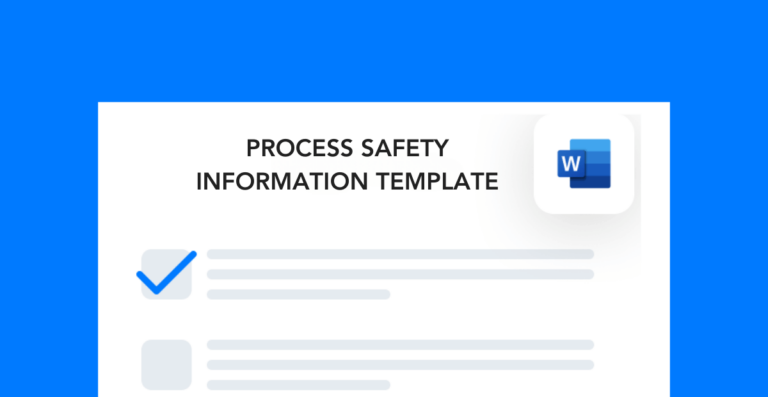For most companies, the hardest part of PSM compliance is keeping up with the recordkeeping requirements. Many of the PSM standard’s guidelines involve some type of formal documentation. The process safety information component is no exception, requiring extensive documentation of the various hazards within your site’s PSM-regulated processes.
[For more information about compliance, head to our PSM resource page.]
Free template!
Download this process safety information template to double check your documentation for all the requirements.
What is process safety information?
Process safety information is the documentation of chemical, technological, and equipment hazards within a process. It is one of the 14 elements of OSHA’s PSM standard.
The PSI requirement outlines the hazard documentation requirements for processes involving highly hazardous chemicals. By thoroughly documenting these hazards, you can better prepare to control process hazards, mitigate risks, and prevent process safety incidents.
What are OSHA’s process safety information requirements?
The process safety information requirement has three main components: chemical hazards, process technology, and process equipment. Let’s look at each of these components in more detail.
Information regarding chemical hazards
OSHA requires you to document at minimum the following information about the various chemical hazards within your processes:
- Toxicity levels
- Permissible exposure limits (PELs)
- Physical data
- Reactivity
- Corrosivity
- Thermal and chemical stability data
- Hazardous effects of inadvertent mixing of different materials that could foreseeably occur
If your safety data sheets meet the requirements of standard 29 CFR 1910.1200(g) and contain the information listed above, then you can use them as documentation for this component.
Process technology
The second component of the PSI requirement is process technology information. You’re required to document the following information:
- A block flow diagram or simplified process flow diagram
- Process chemistry
- Maximum intended inventory
- Safe upper and lower limits for temperatures, pressures, flows, or compositions
- Risk analysis of process deviation consequences (including ones that affect employee health and safety)
If you don’t have the original technical information available, you can document these requirements as supporting information for your process hazard analysis.
Process equipment
The last component of the PSI requirement is process equipment information. Here are the details you need to make a record of:
- Construction materials
- Piping and instrument diagrams (P&ID’s)
- Electrical classification
- Relief system design and design basis
- Ventilation system design
- Design codes and standards employed
- Material and energy balances (for processes built after May 26, 1992)
- Safety systems (e.g. interlocks, detection, or suppression systems)
Within this documentation, you must certify that the process equipment adheres to accepted good engineering practices. Plus, you must also confirm that your equipment is safely designed, maintained, inspected, and operated.
Documenting PSM compliance
It’s easier to document PSM compliance when you break down the standard into its individual parts. You’ll need to tackle each of the documents individually to ensure everything’s complete and accurate.
My best advice would be to keep all these compliance documents in a central place so anyone on your team can access them. This not only makes it easier to maintain compliance, but it also simplifies the process of updating and distributing the documents.
I’d also recommend scheduling periodic documentation reviews and staggering them, so you don’t have to review the entire process safety information component at once. Once you have the proper records in place, compliance should just be a matter of upkeep. If you continuously update your documents as variables enter or exit the process, then you shouldn’t have much difficult meeting OSHA’s requirements.





